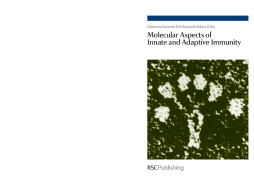
BOOK
Molecular Aspects of Innate and Adaptive Immunity
Lisa Steiner | George T Stevenson | Alex Law | Alister W Dodds | Gerard J Arlaud | Mike Carroll | Jens Chr. Jensenius | Thomas Vorup-Jensen | Nades Palaniyar | Uffe Holmskov | Russell Wallis | Jinhua Lu | Steffen Thiel | A Neil Barclay | Tan Seut Mein | Duncan Campbell | Anthony J Day | Caroline Milner | Begona Aguado | Wendy Thomson | Bernard Morley | Kenneth B M Reid | Robert B Sim
(2008)
Additional Information
Book Details
Abstract
The understanding, at the molecular level, of the interactions between innate and adaptive arms of the immune system is currently a hot topic, particularly to those interested in immunology - especially susceptibility to infectious diseases. This book provides a survey of topics, in the area of innate and adaptive immunity, which have been researched within the MRC Immunochemistry Unit, at Oxford University, over a period of forty years. The topics include: " antibody structure - for which the first Director of the Immunochemistry Unit, Professor RR Porter, was awarded a Nobel prize in 1972 " the characterization of membrane proteins on lymphoid cells - leading to the concept of these molecules belonging to an immunoglobulin super family " the proteins of the human serum complement system - one of the body's major defences against microbial infection " the human cell -surface integrins and the hyaluronan- binding proteins, which are involved in regulation of inflammation at cell surfaces and within the extracellular matrix " the family of collectin molecules - containing distinct globular carbohydrate -binding domains linked to collagen-like regions - which play important roles in innate immunity in the lungs and bloodstream by immediate recognition and clearance of microbial pathogens Each chapter in the book gives a brief historical background to a topic and then provides a survey of recent advances in the field and are written by internationally recognised renowned experts. The theme running through the chapters is that of protein structure-function relationships - including, amongst others, descriptions of quaternary structures of large oligomeric proteins, of Factor H and C1q binding to specific ligands, and of the chemistry of the mechanism of catalysis of covalent binding of activated C3 and C4 proteins to nucleophilic groups on microbial surfaces. In several chapters excellent descriptions are given with respect to how the immune system can be recruited to combat microbial infection - via proteins of both the innate and adaptive immune systems. The book also includes notable chapters which are excellent examples of the importance of how the isolation, characterisation, protein engineering and crystallisation has resulted in a full understanding of complex protein-protein interactions involved in the recognition and triggering events of important sections of the immune system: -Structure and Function of the C1 Complex - GÚrard J. Arlaud -Chemical Engineering of Therapeutic Antibodies - George T Stevenson -Leukocyte surface proteins - purification and characterisation - A. Neil Barclay -Cell Surface Integrins - Suet-Mien Tan and S.K. Alex Law This book is aimed primarily at established senior research scientists, postdoctoral research scientists and PhD students who have an interest in proteins of the immune system. However, the wide range of immunity system topics, while staying broadly within innate/adaptive immunity will also appeal to a wider audience.
Professor Kenneth BM Reid FRS, is Director at the MRC Immunochemistry Unit, Department of Biochemistry at the University of Oxford. Professor Reid is also a Fellow of the European Molecular Biology Organisation and is a Founder member of the Academy of Medical Sciences. In addition to being a member of many prestigious journal editorial boards, he is also the author of over 290 full-length scientific publications, over the period 1967- 2007, dealing with structure-function relationships of proteins of the human serum complement system and analysis of proteins of innate immunity in the lung surfactant. Since 1970 he has carried out research on the structures and functions of components of the human serum complement system and a major focus of his present research includes the analysis of the roles mammalian lectins SP-A and SP-D, as molecules of innate immunity, in the modulation of inflammation, induced by allergy or infection, in the lungs. Dr Robert B Sim is at the MRC Immunochemistry Unit, Department of Biochemistry, University of Oxford. Dr Sim has had about 270 papers published since 1975, plus about 300 meetings abstracts and his main research interests are the activation and regulation of the complement system studied at the molecular level.
